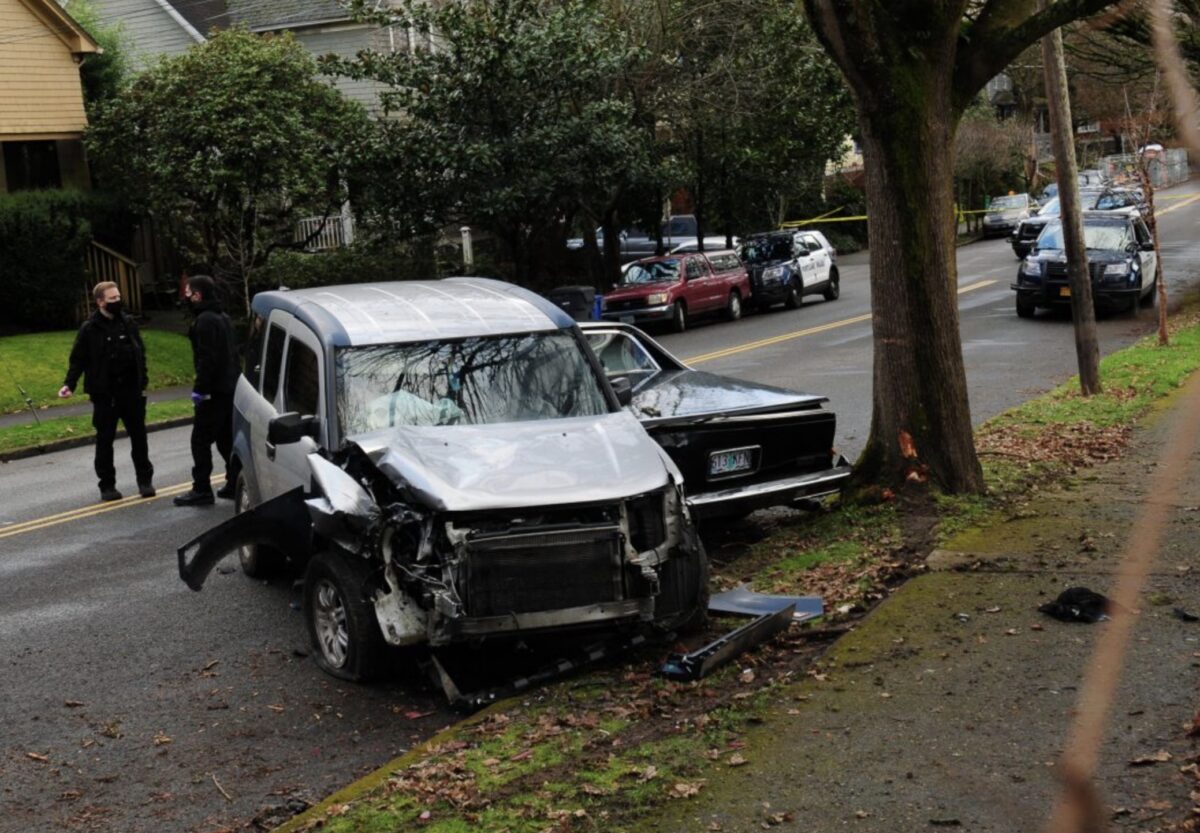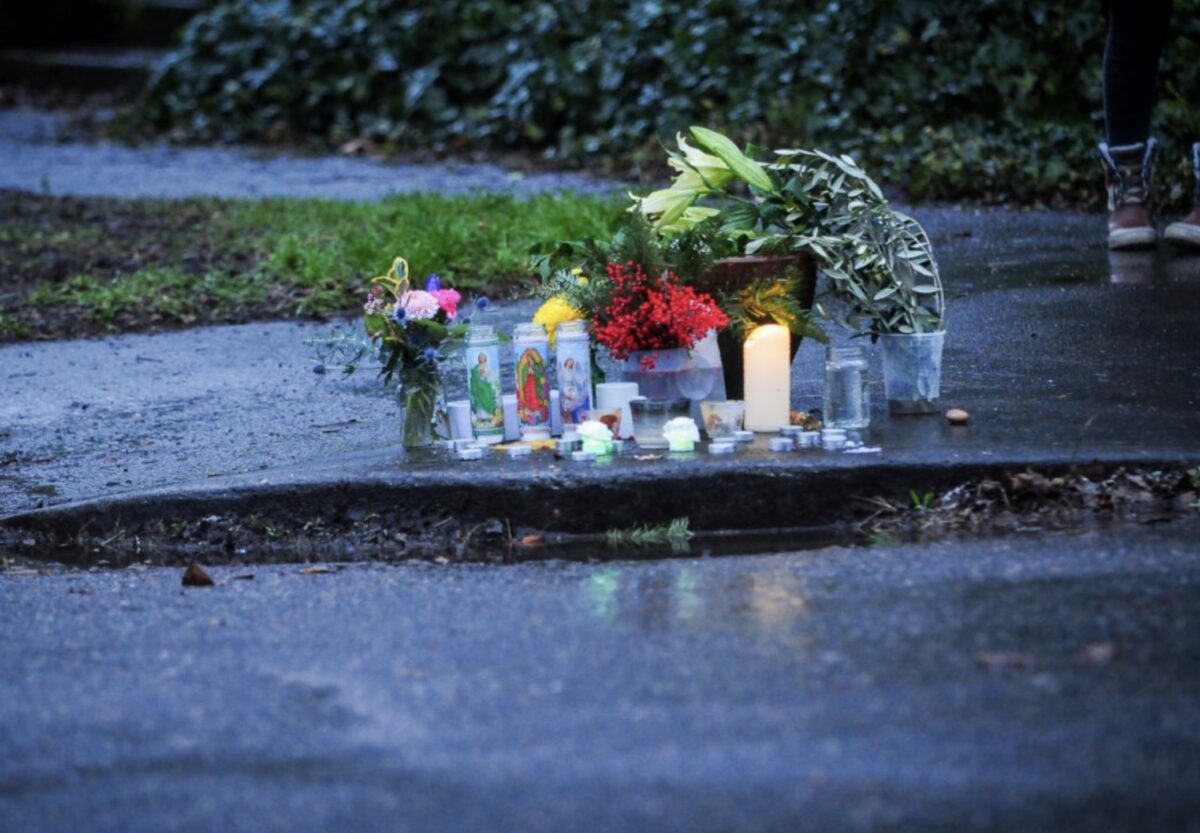
(Photos: Jonathan Maus/BikePortland)
“We need to approach the crisis of vehicular violence with the same urgency and all hands-on deck strategies being implemented to address gun violence”
— Jo Ann Hardesty, Commissioner-in-charge of transportation
“Chaos”, “nightmare”, “terrible tragedy”, “horrific”.
That was how people described the actions of 64-year-old Paul Rivas after he drove his Honda SUV through 1.5 miles of southeast Portland neighborhood streets and tried to run over as many people as he could.
“He accelerated and turned even more towards me,” recalled one of Rivas’ 10 victims who was hit while riding his bike on Southeast 18th. “I had nowhere to go, but was sure he would correct himself somehow. Instead he hit me head-on, lifting me and my bike up onto his hood as he accelerated more.”
That person was lucky. Jean Gerich did not live to talk about what happened one year ago today. She was out on a walk, happy to have recovered from an ankle injury and to have received her first Covid-19 vaccine when she was struck and killed by Rivas. Dozens of people showed up on a rainy night to remember her.
Advertisement
This violent rampage forever changed the lives of its victims. It should have also forever changed how we tackle our collective goal of street safety. But it mostly came and went, dismissed as a one-off “accident” by a man who was easy to point a finger at. Like I shared a day after it happened, Rivas’ murderous acts were not new and they’re likely to keep happening as long as our streets and our society remain so dysfunctional.
One thing that has changed is how some of us talk about traffic violence.
Portland City Commissioner Jo Ann Hardesty, who oversees the transportation bureau and is making a push for re-election based on her record of street safety projects, told me recently that the Rivas incident fundamentally changed her outlook. When I interviewed Hardesty for our podcast last month, I asked her to name one thing she’s done as a result of the Rivas rampage. She mentioned PBOT’s work to “daylight” intersections and to give crosswalk users a head start through intersections — both of which are projects PBOT started long before Hardesty took office.
Given that unsatisfying response, I emailed Commissioner Hardesty to give her another chance to address what happened on January 25th 2021. Here’s what she said (emphases mine):
Advertisement
“This horrible tragedy totally changed my thinking on the necessity to urgently address and talk about vehicular violence. I had never used that language until this incident. Now I believe that language is important to ensure drivers understand the weight of their responsibility operating a vehicle with the potential to cause great harm during a crash. We saw over 60 unacceptable traffic fatalities last year throughout Portland, but this incident was especially sinister as they intentionally killed people utilizing their car as a weapon.
We can improve street safety overall by design and with appropriate enforcement of our traffic laws. That’s why in my first year as Transportation Commissioner, I’ve prioritized fixing our highest crash corridors and rapid street safety improvements – mostly in the long-neglected neighborhoods of East Portland. While those investments are not in the same area as last year’s tragedy on inner Southeast Stark, they will be helpful in mitigating crashes in those neighborhoods. I would love to bring these kind of improvements throughout the City – but I will also prioritize based on the resources available and the data we analyze.
As a proponent of accountability and transparency in policing, sometimes I get mischaracterized as not believing in any kind of law enforcement, which is not true at all. I hope this individual is prosecuted to the fullest extent of the law for the murder and harm they committed. It should go without saying that I support PPB enforcing serious traffic violations. Currently less than half of PPB employees are assigned to patrol and 911 response. I’ve been pushing for a re-alignment that allows more officers to be dispatched to Portlanders immediate needs.
This is also why we need more speed safety cameras and traffic light cameras to help enforce our traffic laws. I’ve been pushing for the policy changes that will allow us to do that as we wait for supply chains to produce more of these cameras. Once we get them, PBOT will be ready to install them.
The combination of improved safety infrastructure and enforcement for serious traffic infractions is what will bring more calm and peace to our streets. I’m grateful my Council colleagues supported my $450,000 request for rapid street safety improvements last year, but we must acknowledge that is a drop in the bucket compared to the millions we are investing in mitigating gun violence, despite a similar number of fatalities resulting from both crises. We need to approach the crisis of vehicular violence with the same urgency and all hands-on deck strategies being implemented to address gun violence. If we do that, we can help ensure another tragedy like what occurred one year ago isn’t able to happen again. My colleagues are beginning to understand the gravity of the traffic violence occurring on our streets and I hope advocates will push the entire Council, including myself, to make this a top City priority in 2022.”
Advertisement
I just witnessed a car going at least 50 mph down Morrison the wrong way, turn onto 10th, take out all the bike racks and almost run over the man on the sidewalk.
— SaySay Boutique (@saysayboutique) January 20, 2022
Sadly, we don’t even need to rely on what Rivas did to help us see the epidemic of traffic violence in Portland. In the past year, it’s been around us every week (note the date on the above Tweet). It comes in different forms, like speeding and drunk driving and hit-and-runs, but it is just as violent and deadly to the people who feel the devastating impacts.
Much like this problem remains acute, our system is still trying to bring Paul Rivas to justice.
After pleading not guilty to the 31 charges (including eight felony murder charges) against him, a judge deemed Rivas unfit to stand trial in May 2021. According to court documents and sources at the District Attorney’s office, Rivas was later evaluated by the State Hospital and found able to stand trial two months later. Today he remains in custody without bail and is scheduled to appear again in August with a jury trial set to begin in September.
While consequences for Rivas and justice for his victims is important, we focus on him as the cause of this violence at our own peril.
The question we should ask ourselves is: If our society and our streets create the perfect storm for vehicular violence, does it really matter if it’s intentional or not?




